by meghanleborious | Jul 31, 2016 | Notes on Practice, Uncategorized
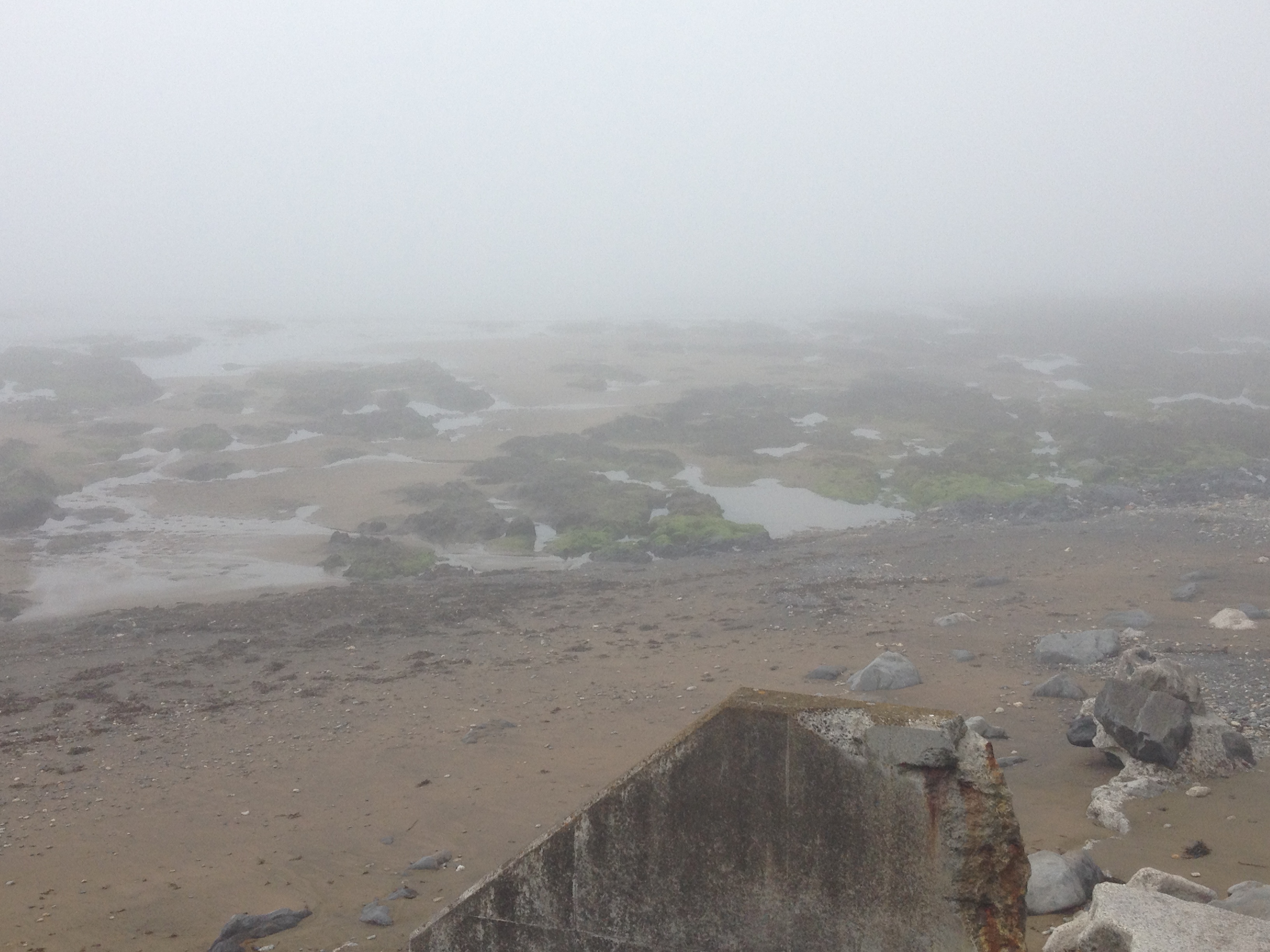
Otherworldly fog took over the landscape on Monday. After dropping my six-year-old son, Simon, off at camp in Dunhill, I went to the unmarked beach again. Suffering from heavy anxiety, I paused to look out over the vast beach from the top of the steep cement stairs, and the line of vision was severely blocked by the heavy white cloud.
Exploring and seeking an inspiring place to dance, I walked west, passing several beaches that were framed by giant, fallen boulders. I came to a cave (or perhaps the shaft opening of an old copper mine) and investigated briefly, then suddenly realized that I had no phone reception whatsoever. I was nervous about being out of contact while Simon was at camp. Lately, I have been unusually nervous about keeping us safe, given a series of mishaps. Simon has also been nervous, asking me to sketch out endless scenarios of what would happen if one of us got hurt or died during the trip; and he has been unwilling to be apart from me in any room of our friend’s 300-year-old cottage, as he believes it haunted. I have tried to calm his fears, but at times I have also felt afraid. I held the phone in my hand and walked back toward the cement stairs, staring at the screen and pausing whenever it said, “searching.” I settled on a still-remote-from-the-stairs spot with very black sand where the signal flickered in and out. I put the phone on a rock where I could check on it, created a large circle in the sand that I could dance inside of, then settled into a patient Flowing. As Staccato arose out of Flowing, I went to check the phone and realized that it was again saying “no service.” I tried to talk myself into letting go of the nervousness about being out of contact.
In the end, I was able to re-connect with Flowing despite pausing to check my phone. I danced a brief wave, moving through each rhythm: Flowing, Staccato, Chaos, Lyrical and Stillness. Resuming after the pause to check the phone, I realized that despite the fog and mist, the day was warm. I took off my clothes. The feeling of the cold mist on my skin helped return me to my senses and release the anxiety I was feeling. It was exhilarating after being so wrapped up in garments for so many chilly days. Before long I returned to a bathing suit, completing the wave fairly quickly. Stillness emerged vividly and the felt senses of the cliffs, the sea, the mysterious and heavy air, and the rocks and boulders found their way into my movements.
Then, I moved to the opposite end of the beach, where it was much less remote, but where I did have reception. For this second wave, as with the first, I started by creating a circle in the sand to dance inside of, though I did not stay inside it except for in the beginning of Flowing. This wave was definitely practice. Bits of beauty flecked it, but I was not particularly inspired. I was left thinking about how anxiety blocks receptors to everything—to danger, to joy, to fluid experience, and to the constant stream of information we receive from the world around us.
In the brief time I had before picking Simon up from camp, I made an unsuccessful attempt to find an ancient site that my friend had urged me to visit, but the next day (Tuesday) I was determined. I re-traced my driving steps, remembering not to turn down the tiny, stone-walled lane where I had aroused suspicion the day before. I had a map my friend’s archaeologist neighbor had given me, which included all of the small rural roads. Even armed with it, it was very difficult for me to navigate. I was told the site was just next to a cow field, and that it was locked gate but that there was a stile—a gap in the gate—that allows people to enter. That description seemed to match pretty much every gate I passed. I asked a woman who was walking on the road if she knew of the site, and she scrunched up her face, looking upward to think and pointing downhill. “I’m not sure, Pet. I think it might be down there, but they’re building a house there now. I suppose you could go there and ask if you could enter.” I felt discouraged, but decided to go just a tiny bit farther down the road. Shortly, I actually did find what I was looking for—indicated by a discreet arrow sign that said, “Gaulstown Dolmen.” I walked through the stile, down the driveway, through another entrance, then down a wooded path.
The monument is remarkable. It consists of six very large, flat stones that were placed in a Stonehenge-like configuration around 5,000 years ago. No one knows exactly how, as they appear to be extremely heavy. According to the archaeologist, it is likely a burial site, based on nearby similar sites that have been excavated. There was a small clearing around the dolmen, but it was very much enclosed with grown over trees and grasses. I sat for a few minutes, then got up to walk in a circle around it. Prickers caught my long skirt; and I moved into a flat spot to dance in Flowing. Absorbed, I imagined a low, chanting hum as I listened and sensed the place. I saw a moving black shape out of the corner of my eye that could have been the farmers’ dog, but that got me to thinking of ancient spirits. Staccato was brief but expressive. In Chaos, I stepped right inside the dolmen, wondering if it had also been intended as a portal. I was slightly afraid of the possibility of possession and at once totally fascinated. In Lyrical a flash of creative energy entered into me. In Stillness I moved with reverence—an homage to the ancients. I was left feeling like I should do what I can to develop my capacity as a mystic, and that all I need is available in every moment, if I know how to pay attention properly.
Later, I went again to the secret beach. Reception was better without the fog, and I choose a spot that was not as remote. Still, the phone came in and out. The day before I’d told myself, “Maybe I can be ok with being out of reach for a little while.” When it came to it, I was still nervous, and couldn’t bring myself to practice until I found a spot where the phone would have at least one bar. I stayed in Flowing for a long time, returning to the image of the dolmen again and again.
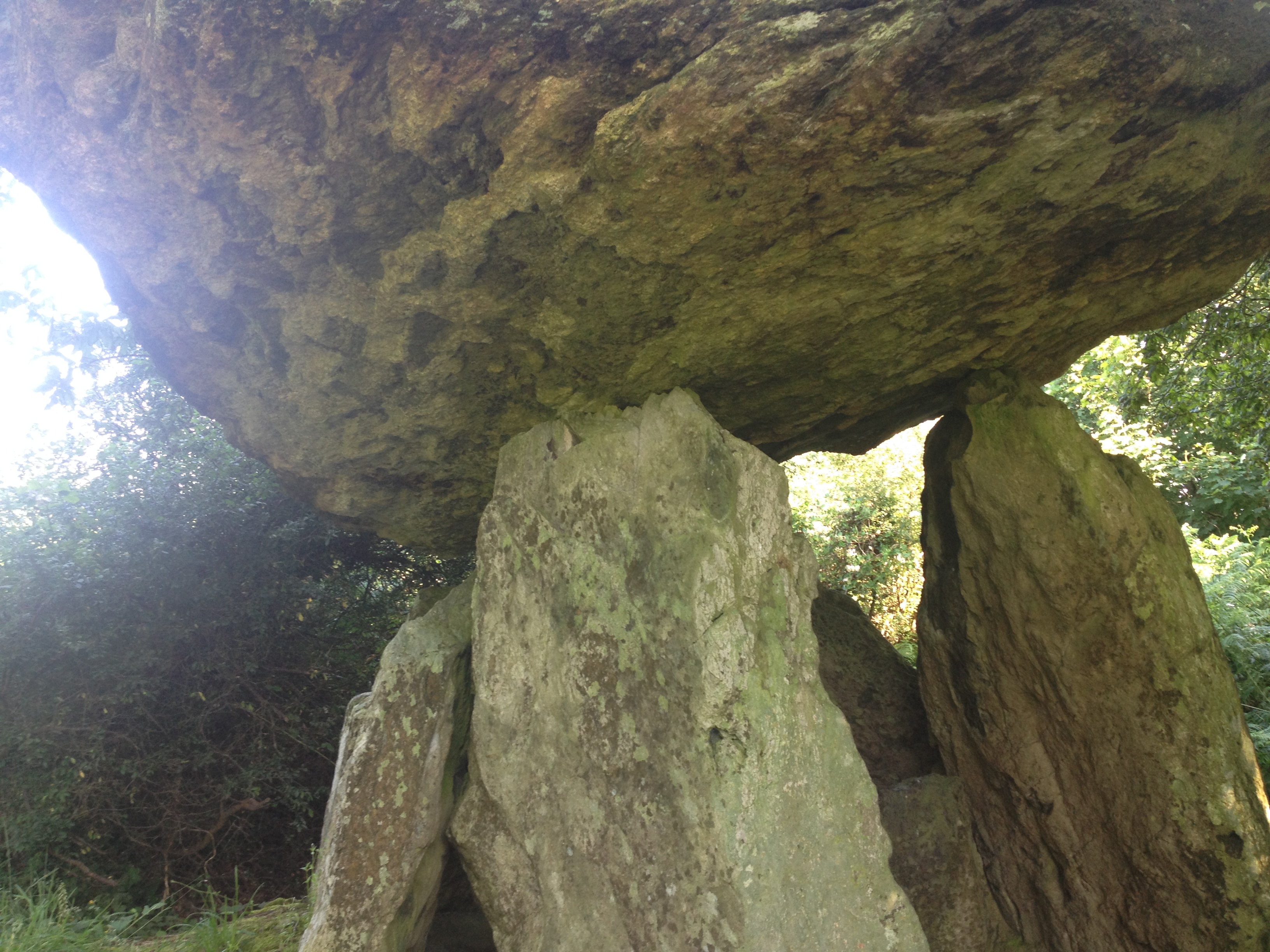
As with previous dances, threads of Stillness continued to present, for example during Flowing when I witnessed a bird soaring absolutely in place, not moving at all, buoyed by strong wind. I realized that at times I have confused Inertia—which can present as a lack of energy and is considered to be the “shadow” of the rhythm of Flowing—with Stillness. Stillness, as it continued to present during my many dances with the land and sea in Ireland, was very much invigorated and alive.
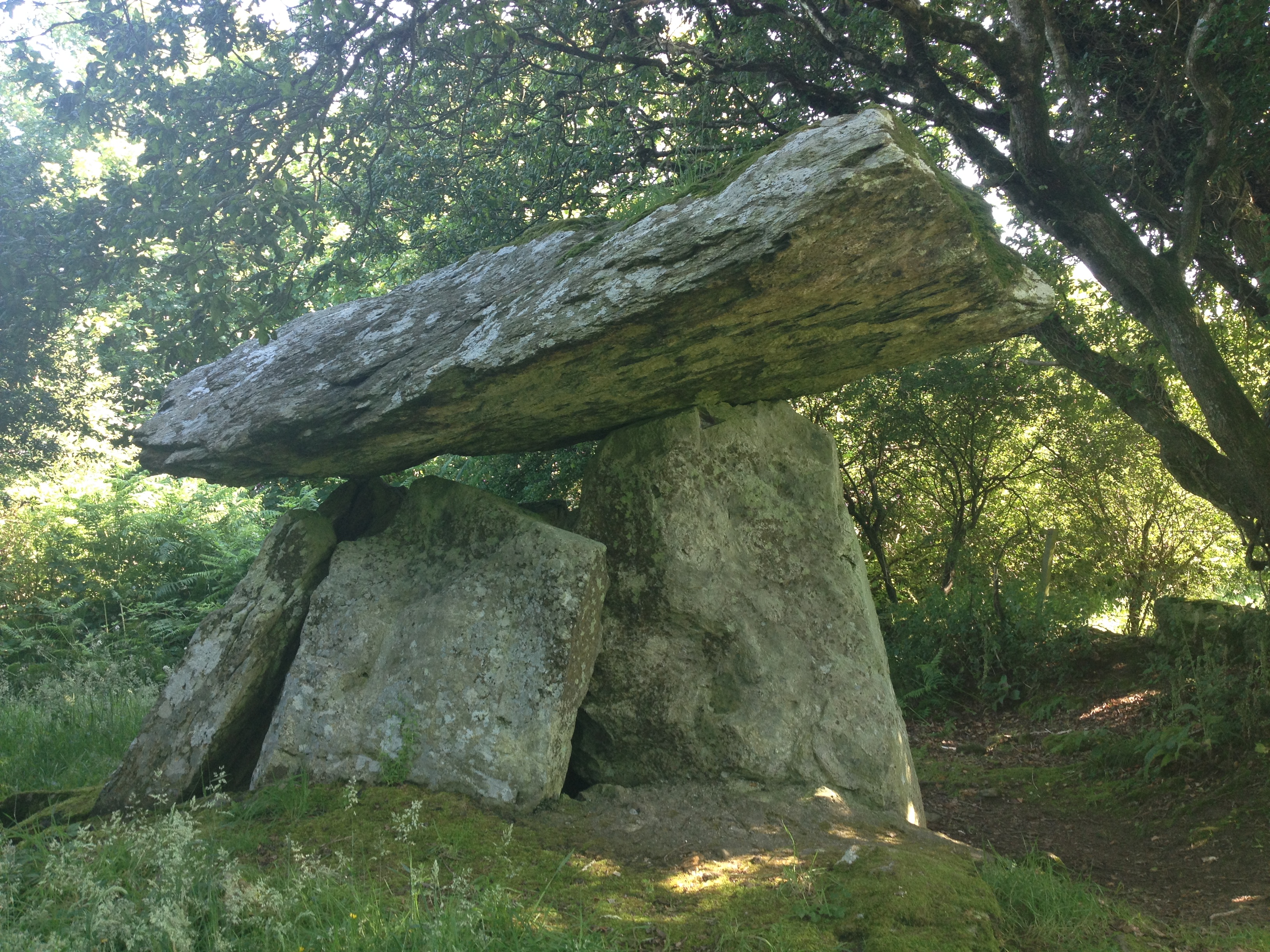
The rest of the wave unfolded. Staccato started only after a long time in Flowing; and I returned many times to Flowing even after I had fully entered Staccato. Staccato was not very energetic until Chaos began to appear, then the last burst of Staccato was very vigorous. I covered vast ground, moving far beyond the little circle I had drawn in the sand at the beginning of Flowing, all the while taking in the landscape even as it flashed across my field of vision in Chaos. In Lyrical I again played with my version of Irish step dancing. In Stillness I experimented with concentrating my energy field close to my body, then extending it far beyond my own edge. I ended the wave with my feet firmly planted and wide apart, holding my hands together in front of my chest, standing still and facing the sea, sensing myself as a colossus—taller even than the high, green cliffs.
The next day was the final day that I was able to dance in Ireland during this trip. As soon as I dropped Simon off at camp, I went to the secret beach, where it was again overcast and deserted. I spent some time creating an artwork, then drew a circle in the sand around myself and began to move in Flowing.
From the beginning, this wave was alive. In Flowing, I moved with ease and freedom far beyond the outlines of my little circle. The weather started to improve and a few people made their way down the cement stairs. Shy about occupying so much territory, I moved back behind some boulders, though I was still partially in view. Flowing shifted into Staccato and I covered even more distance, discarding my concerns.
I tracked the subtle shifts of energy, moving intuitively. The wave followed this pattern, if I recall correctly: Flowing, Staccato, Flowing, Staccato/Chaos, Staccato, Flowing, Flowing Chaos, Chaos, Flowing, Lyrical, Chaos, Lyrical, Chaos, Flowing, Flowing Lyrical, Stillness. I let everything in, deeply sensing the enormity and vast power of this incredible place. I went into Lyrical two or three times inside of Chaos, rising up onto my toes. In Stillness, I returned again to the original circle I had drawn in the sand. I invoked deities, helpers and guides, including Gabrielle Roth—the creator of the 5Rhythms practice—asking for help on my path, a clean heart, and the courage and insight to live my life in service to love.
I picked Simon up from the little, rural camp a little early since it was his last day. The camp included only children from the small, local villages; and most had multiple siblings. I told Simon I was incredibly proud of him for having the courage to step in and find his place there. As we moved toward the car, many of the children hung over the fence, waving, and calling out, “Bye, Simon!” The next day, we set out for home.
This blog consists of my own subjective experiences on the 5Rhythms® dancing path, and is not sanctioned by any 5Rhythms® organization or teacher.
by meghanleborious | Jul 17, 2016 | Notes on Practice, Uncategorized
-
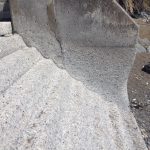
Yesterday we woke to blue skies for the first time since we have been in Ireland. After dropping my son, Simon, off at camp, I set out to explore the local beach again, hoping to find a place to dance. Given the fair weather, there were several people enjoying the beach and I didn’t feel comfortable dancing there. Because it is exceedingly dangerous, I’ve sworn off the unprotected cliff path that departs from the east end of the beach, despite its compelling beauty. I spotted a different cliff path at the west end of the beach and decided to at least try it. This time, most of the path was set back from the cliff’s edge (with the exception of one short section) and I felt more at ease. The vast horizon was striated with deep emerald and turquoise water. Views from the cliff walk included huge rock formations topped with greenery, toppled boulders, squared green fields, rock walls and the endless crashing waves far below.
Absolutely by chance, on the secluded cliff path I ran into a childhood schoolmate of the friend who is hosting us and we chatted briefly. “I think it is a little bit dangerous up here. There has been a lot of erosion lately,” she shared. I nodded and told her that I decided I wouldn’t go on the other cliff path anymore; and that I am trying to play it safe, given a number of holiday calamities.
Reaching the end of the cliff path, I saw a beautiful, unpeopled beach far below. There were only sheer cliffs in front of me and there didn’t seem to be a way down, so I decided to try to reach it by way of the road. Returning, I avoided the one very dangerous section of path by detouring through a heavily prickled patch. I turned off the path and walked through a field, hoping I could avoid returning all the way to the beach I’d started at, but a wire fence that I feared might be electrified blocked my way. I returned to the beach where I’d started, then turned onto the road and tried to find the secret beach. I regretted my choice to walk, as a long section of the road was treacherous for pedestrians, but I jogged along in my flipflops, hoping to get out of the way before any cars came barreling along. I got off the road as soon as I could, then walked parallel to it through someone’s field. Again, I reached a dead end, totally blocked by impassable shrubs and brambles. Determined still, I returned to the cottage and got into the car. Driving west, I spotted a nearly concealed, unmarked road in the middle of a hairpin turn and turned onto it.
The graveled parking lot was at a 45-degree angle and I made sure to engage the parking brake to the last possible “click” before getting out and gathering my things. This was, surely, the secret beach that I had seen from the cliff path. Despite the first-in-many-days blue sky, there wasn’t a single person besides me.
There were two graphic signs on the stairs leading to the beach below indicating falling rocks and strong currents. The stairs were made of concrete with big, coarse rocks cast inside, and were very, very steep. The first flight was relatively intact with the exception of a few crumbles, but on the second flight the stairs were severely eroded, smoothed almost to a flat ramp in some places by powerful high tides.
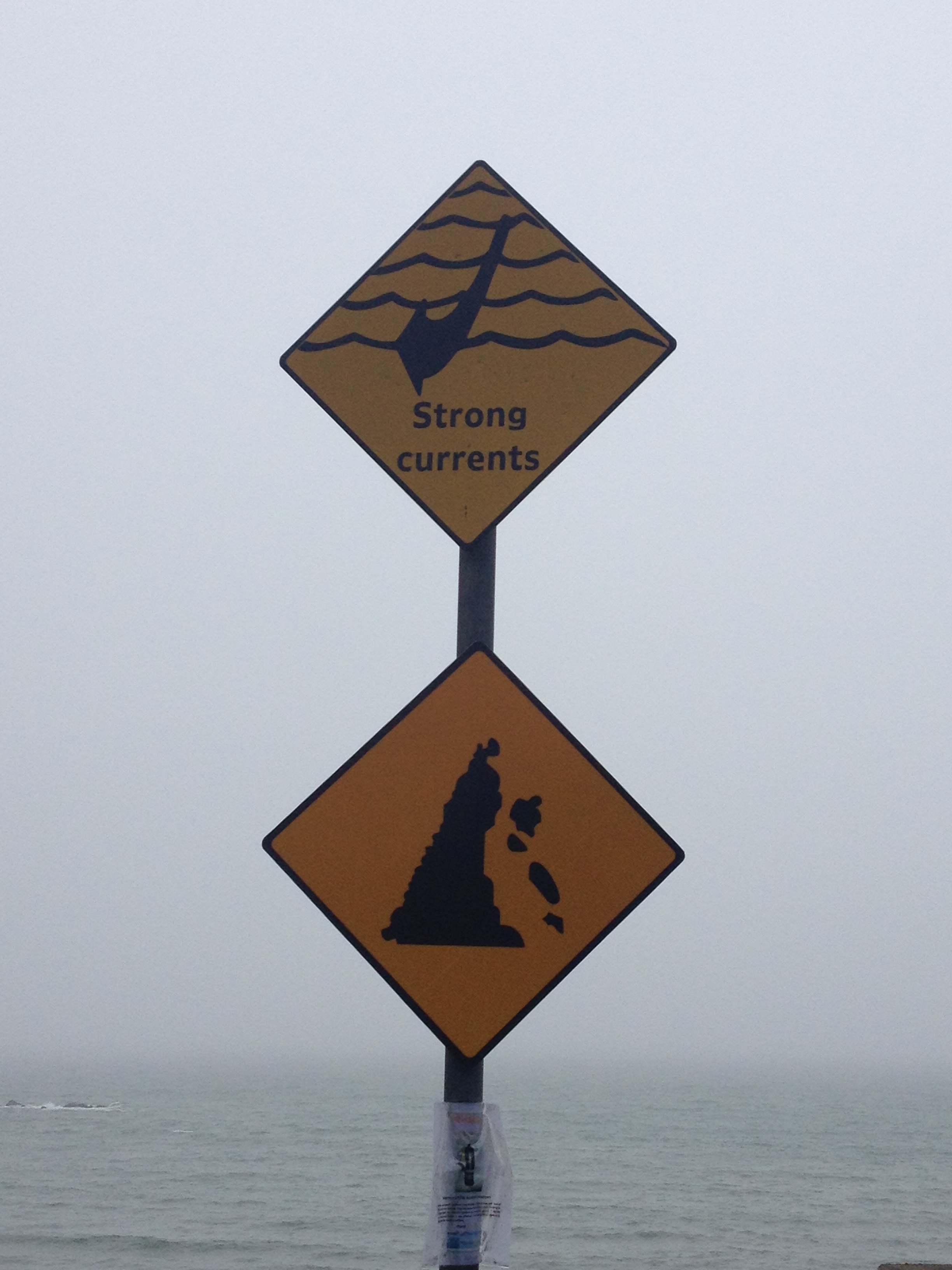
The beach itself was remarkable. Soaring and crumbling cliffs formed its north face, with fields and endless plants and grasses visible above them. Green-topped rock islands jutted into the sea at both its ends. Rocks and boulders were cast throughout the water, causing the powerful waves to act erratically. Thankfully, it was near low tide, since based on the most recent high tide line, the beach would be treacherous at high tide, if at all accessible. On a stormy day at high tide, the waves could reach the top of the long stairs, pummeling the cliffs and beach and making access impossible.
Looking up, I could see the crumbling cliffs with the turf edging hanging down like thick carpeting. I resolved once again, firmly, to stay off of high cliff paths that are right on the edges of cliffs.
I wasn’t totally sure what stage the tide was at, and I eyed the sea warily. This is dragon land, without question. I ventured a short way down the beach, but chose a spot to dance that was a short sprint away from the steep, cement stairs in case high tide came in fast. I made a circle of stones for myself and also noted a cluster of round stones a short distance in front of me. If the sea reached those stones, I decided, I would call it day and head for the stairs, no matter what phase of the 5Rhythms wave I was in at that point.
I broke the crusty surface of the warm sand with my bare feet. As with the previous day, moving brought tears almost immediately. I don’t know how long I was in Flowing, but I do remember that it was characterized by totally unselfconscious, fluid movement. In Staccato, I moved along the beach so I could dance on the unbroken sandy crust instead of in the sand that was already churned up by my circling feet in Flowing. I felt a tiny bit restrained. Respectful of the danger around me. Chaos, as in the previous days, was slightly restrained, also. I endeavored to release my head, but never moved with wild abandon. In Lyrical, I traced the gliding movements of birds with my hands while raised up onto my high toes, seeking sections of unbroken sand to help with lifting upward.
Stillness in the first wave took its time. I let in the energy of everything around me—cliffs, ocean, sky—and it was almost overwhelming. I had the thought that if you really let in the reality of the absolute, you let in the reality of your own death, too, and let in the reality that those you love will one day die. I staggered a little at the enormity of it, and at the wondrous enormity of the landscape around me. Perhaps that is why it can be so frightening. Sometimes. For me.
One of the biggest benefits of practicing independently is that I can really work with the mercurial shifts of energy as they arise. I realize that (in previous days) it made no sense to “hold” myself in Flowing. The fact is that even once I did move into Staccato, I moved back into Flowing many times. It wasn’t an all-or-nothing thing. Even when I got to Chaos, I still found myself going back to Flowing. I have often felt that I needed to keep myself in Flowing longer than felt intuitive so I could be responsible and find the ground beneath me before taking on any other investigation. Here, the stakes were different. I needed to attend to the many small subtle shifts of energy as I fluctuated between different rhythms. And in doing so, the energy of the land started to reveal itself to me.
It was not what I expected, to say the least. The land or anything else about Ireland. I have contemplated my relationship to this place at length. My Irish American grandmother and aunties were very Irish identified, but as I became an adult, I related uncomfortably to this heritage. I can see how identifying strongly helped them to feel empowered (perhaps in the face of discrimation), to connect with their families and community, and to find meaning and purpose. For me, though, several generations removed, taking it on has felt more like an identity decision, not a real connection to a living culture. Before this trip, I thought, “Perhaps I could connect with this lineage in a real way, and claim this one of many parts of who I am.” I felt strong emotion in the Waterford museum in Dungarven reading about the famine, the independence movement, the seafaring history. And in talking with one well-dressed, sweet, old Irish lady, who strongly remembled my now-gone beloveds. And again, at a country fair, seeing teenagers in a dance performance—jaunty, alive, lyrical. The peasant history, the mystical strains, the aching land. I know all of this in my body. And yet I have felt distant. And more afraid here. I hope I haven’t betrayed my ancestors. My heart wants to be open, though. Perhaps there will be a breakthrough.
The second wave emerged organically. Again, in Flowing I moved in linked, concentric circles, totally unselfconsciously. I found a melody that has appeared in independent practice again and again, feeling like an ancient song. Since I was totally by myself (except for one lone man in a blue jacket, a tiny dot far on the other side of the beach), I sang it with full force. It morphed into a chant—an homage to the sun that had tremendous density and power, and that persisted for most of the second wave. A thread of Stillness passed through as I danced with five black birds who soared together overhead—crossing, dipping, and gliding. The gestures of Chaos arose totally from the angles of my feet in the already agitated sand. In Lyrical, I again found lift, in my own joyful version of Irish step dancing. In Stillness, I let the waves pass through me; and at the end of the wave, I sat briefly in meditation, cross legged on a towel on the sand.
Today, I went again to this achingly beautiful, secret beach. First, I carefully checked the tide charts, since I did not want to be caught far from the stairs in a rising tide. This time, the sky was not blue, but white; and I walked west instead of east. The horizon was a vague shift in densities. Although according to the tide chart I should be ok for over an hour, I continued to fear the possibility of a quickly rising tide and watched the sea carefully. I explored at length, passing the first open beach to a set of giant rocks that would surely be islands at high tide, and on to another open beach (this one with black sand) and to another set of giant rocks. Everyone makes such a big deal about the greenness of Ireland, but here, the power of Ireland’s ancient rocks and stones presented. The stones became anthropomorphic as they began to reveal themselves, and I saw not only people, but animals and otherworldly creatures. I shot them with the phone camera like I was doing portraits; and they revealed themselves even more.
I crossed paths and chatted briefly with the man in the blue jacket that I had glimpsed far down the beach the day before. I noticed that he was attractive and we chatted about the weather. He asked if I planned to swim. In keeping with my recently established personal guidelines about safety, I asked, “Is it safe to swim here?” He said, pointing, “Well, you don’t go out too far, just in that part there.” I didn’t fully take it in, believing the sea much too cold, and said, “Well, have a great morning!” and moved on.
I finally had my fill of exploring, and selected a place close to the sea-damaged escape stairs. In fact, I found another cement staircase and the remains of a man-made walkway that had been totally pummeled and melted by the sea. I fell in love with it—this sturdy man-made creation that was easily felled by the raging power of the ocean. It was both humbling and heartening. Humbling because of the failed hubris of creating human structures on this wild beach. Heartening because nature so quickly reclaimed and restored itself in the face of human intervention—making our constructed foibles look like mere flashes in the pan.
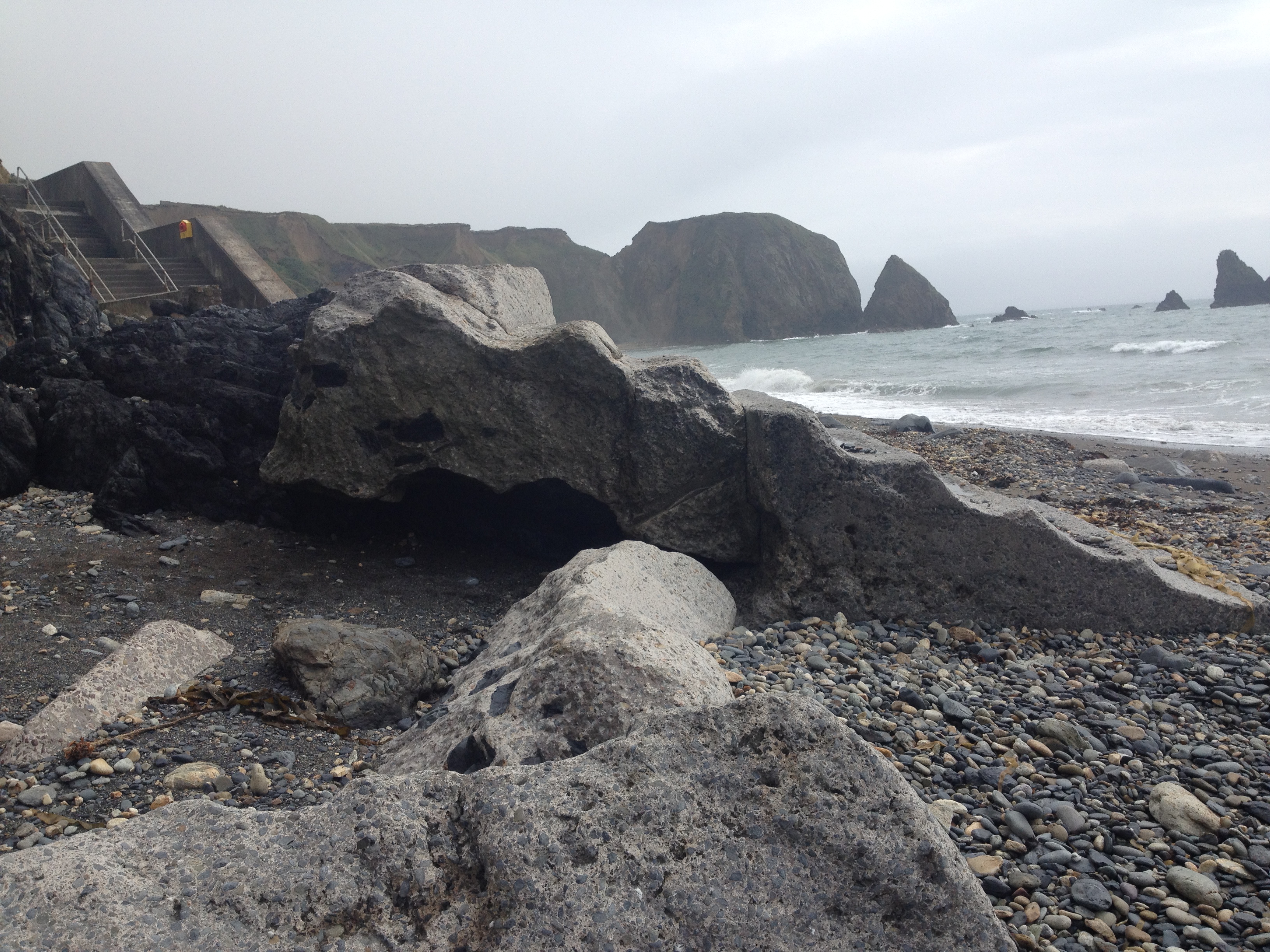
In Flowing, I was happy and at ease. I felt no exertion, no inertia and no self. In Staccato, I felt no urgency or strain.
I saw the man I had spoken with swimming far down the beach, and began to feel like we were sharing a dance. After a long while in Flowing, I realized he had finished his swim and was standing by the escape stairs, drying off and watching me. This was an interesting development. I let Staccato emerge fully, rushing into space far beyond the original circle that I occupied in Flowing, some bold back cross-steps and deep squatting gestures working their way in, as I grew taller, smiling and engaging fully with the sometimes conflicting gestures of breaking waves. I kept glancing at the man, very aware that he was watching, but never made eye contact with him. I wanted to speak with him, to connect with him, but I lost my chance. As Staccato transitioned, I saw that he was walking up the stairs. I had suspected that he was naked but at this time it was confirmed. I waved good-bye to him, wishing he would come back and telling myself, “Oh well, he’s probably married anyway, like almost everyone in Ireland.”
This got me to thinking of physical love, and of the many memorable lovers I have met in my travels over the years. I thought about another beach meeting, near Puntarenas, Costa Rica. In that instance, I was on a long vision quest on the beach, lone, ecstatic, far from the village I was staying in, when a beautiful man literally rode up on a black horse, stopped short and said, “I want to dance with you!” Yes, I said, “Como no?” (Ironically, I never had sex with the horse riding man, who I quickly fell in love with, but instead entered into a primal tryst with an itinerant surfer from Argentina who sold jade jewelry to tourists and lived in a lean-to on the beach.)
For a spell, I was distracted from my senses. Chaos did not so much arrive as support my intention to complete the wave. Spinning, I quickly grew dizzy on the tilted plane of the beach, then found a familiar way of moving in Chaos that I realized is just a very articulated and weighted way of spinning. I moved in and out of Chaos, Lyrical and Stillness again and again, letting the flow of energy have its way.
This place, where two twisting strands of my ancestors hail from, is not what I expected. The pre-digested Ireland of cartoon leprechauns and Blarney Stone kisses is only a tiny piece of the story. In reality, it is much scarier. Much darker. Incredibly beautiful. And still, totally foreign.
July 16, 2016, Annestown, Co. Waterford, Ireland
This blog consists of my own subjective experiences on the 5Rhythms® dancing path, and is not sanctioned by any 5Rhythms® organization or teacher.
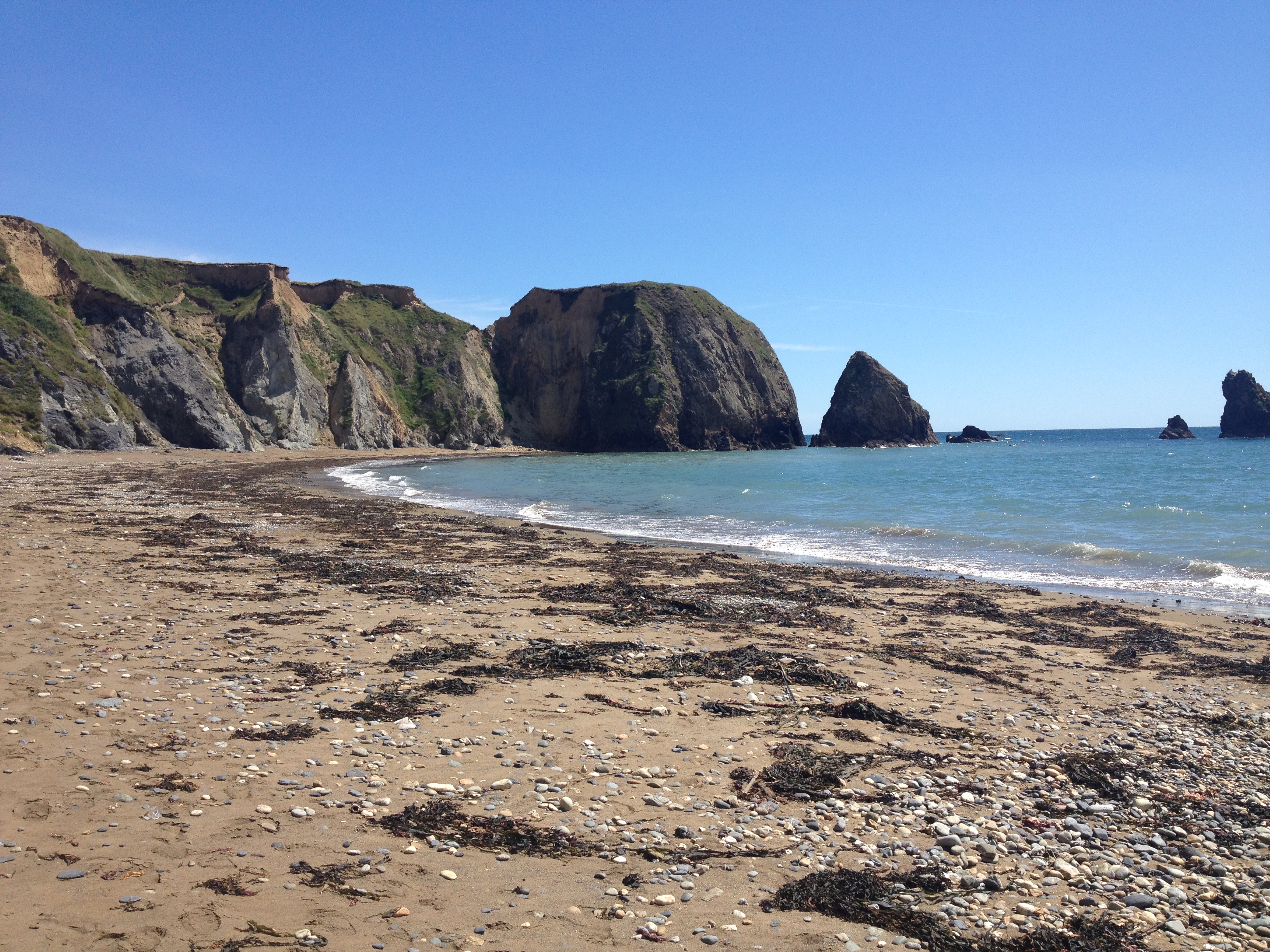
by meghanleborious | Jul 14, 2016 | Notes on Practice
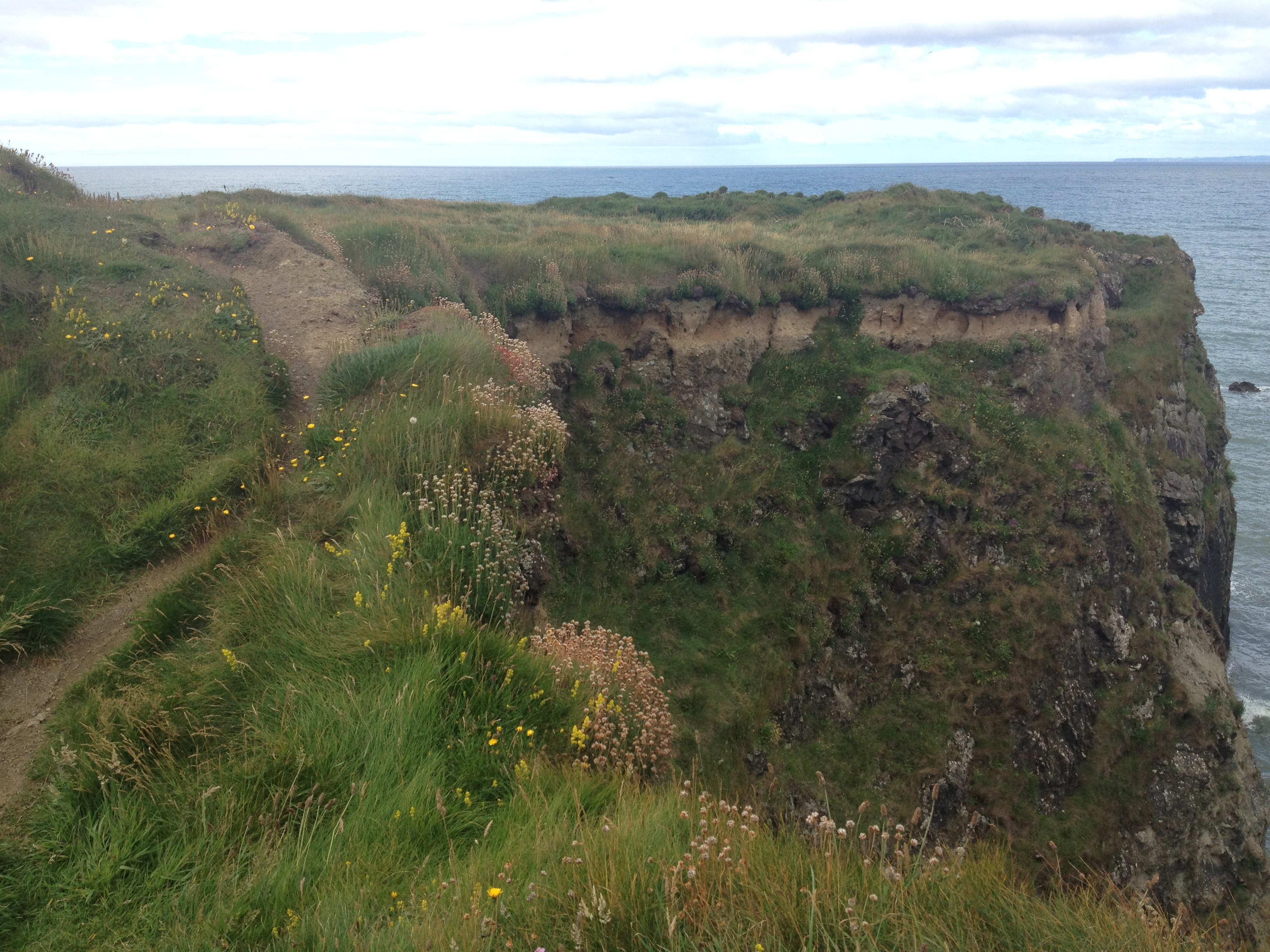
I was overly optimistic in putting on a bathing suit. During a brief glimpse of blue, we rushed to get to the sea, hoping for at least a few moments of beach fun. As it was, the blue was enclosed again by white sky long before we made it to the beach, but we decided to explore anyway. We found a place to park near Bonmahon Beach in Co. Waterford, Ireland and set up the sandy path to the sea. I shivered with a three-quarter sleeve sweater and my six-year-old son, Simon, complained—between designing games with sticks, investigating the tidal river, running toward the roaring waves, and creating performances for an imagined audience modeled on a show we had seen in Galway the week prior—that his hands were cold in the wind.
Monday, I finally got to practice formally as Simon attended his first day of camp in Dunhill.
I dropped Simon off at camp, lingering while he acclimated. Most of the other children were part of large family contingents, and I wondered how he would fare. I had been awake the night before, anxious about entrusting him to new people. I also kept reviewing an incident of a few days before, when he and I climbed to the highest point of a castle ruin. I regretted my decision as soon as we climbed up, and had a moment of intense fear as I gathered the strength and focus needed to get us back down. When I was checking out the climb before I ok’d it for Simon, he stood for a moment with his back to an extremely steep, crumbling stone staircase. I gasped and drew him to me, reminding him to never turn his back to a ledge or a staircase. I kept re-playing it and re-playing it, realizing that no matter how many times you say it, a six-year-old is unlikely to have the mindfulness needed to manage things like climbing up dangerous rocks. With camp looming, this episode that had felt like an adventure a few days prior now felt like terror. Our trip has been filled with challenges; and I realize that fear has begun to encroach on my peace of mind. As it was, the camp seemed safe, spacious, uplifted and cheerful; and he quickly joined a group of his peers.
I was very eager to practice and to venture on my own. I returned to my friend’s lovely thatch cottage that is our temporary home and gathered what I thought I might need. I walked across the street and down a little overgrown path to the Annestown beach. I wandered to the east end, investigating the attributes of high tide, then made my way along over piled, large, round stones to the west end of the beach where I knew there was an unprotected cliff path. I had embarked on the path a few days before with Simon, but quickly realized that it was too dangerous, especially given his punchy mood at that moment, and turned back. Stepping onto it again, I couldn’t believe I even considered it with him. On one side there was an electrified fence protecting an open meadow of grazing cattle. On the other, high cliffs dropping down to open sea. I moved along the path slowly, choosing my steps. Once, I stumbled on the small, loose rocks that littered the path and was very grateful that I hadn’t stumbled on one of the most dangerous sections directly above sheer ocean cliffs with no buffer of grass between.
I followed the path as far as I could, until I wasn’t sure at if it was just a run-off ditch for water or an actual path, then picked the most beautiful spot to practice. I returned half-way back along the cliffs then turned left onto a path that lead to the end of soaring bluff. It was totally flat, and featured a lush meadow of perhaps fifteen feet across. I crawled out on my belly to look over the edge, but as the tip of my nose reached the tiny red flowers growing in the side of the cliff, I decided it was too dangerous and squirmed back, fearing that the rock at the edge might crumble. Below, the sea churned and two small, rising, green-covered islands sustained the pummeling waves. I placed my flip flops and bag three or four feet in from the ledge to remind me to stay away from it, even as I started to dance.
I tend to be intrepid and to love the sharp edge of mild danger, but this time, practice was restrained. In Flowing, I was reluctant to move my feet. This was partly because of the liberal amount of rabbit shit in the thick, green grass, partly because of some tiny, sharp sticks that hurt to step on, partly because of the real possibility of falling to my death, and (surely) partly because I have had a recent spike in fear, resulting from a series of confidence-shaking experiences since the beginning of this trip.
At once, it was exquisite. A vast, moody sky stretched for endless miles. I could feel the sugar in the bright grass and had a powerful felt sense of the carved cliff beneath me. The waves crashed below and moved around the islands in dynamic, unpredictable patterns. Winds presented strongly, too, filling my ears and applying their own force. My senses were full of the elements and I let them fill me and pass through.
I felt pulled quickly to Staccato, but resisted, hoping to dance for at least an hour and thinking I should spend more time in Flowing. I also hoped that Flowing might open up more, and that I might find more flexibility and ease. After some time of moving in Flowing—sometimes with subtle inspiration and sometimes vaguely—I moved into Staccato.
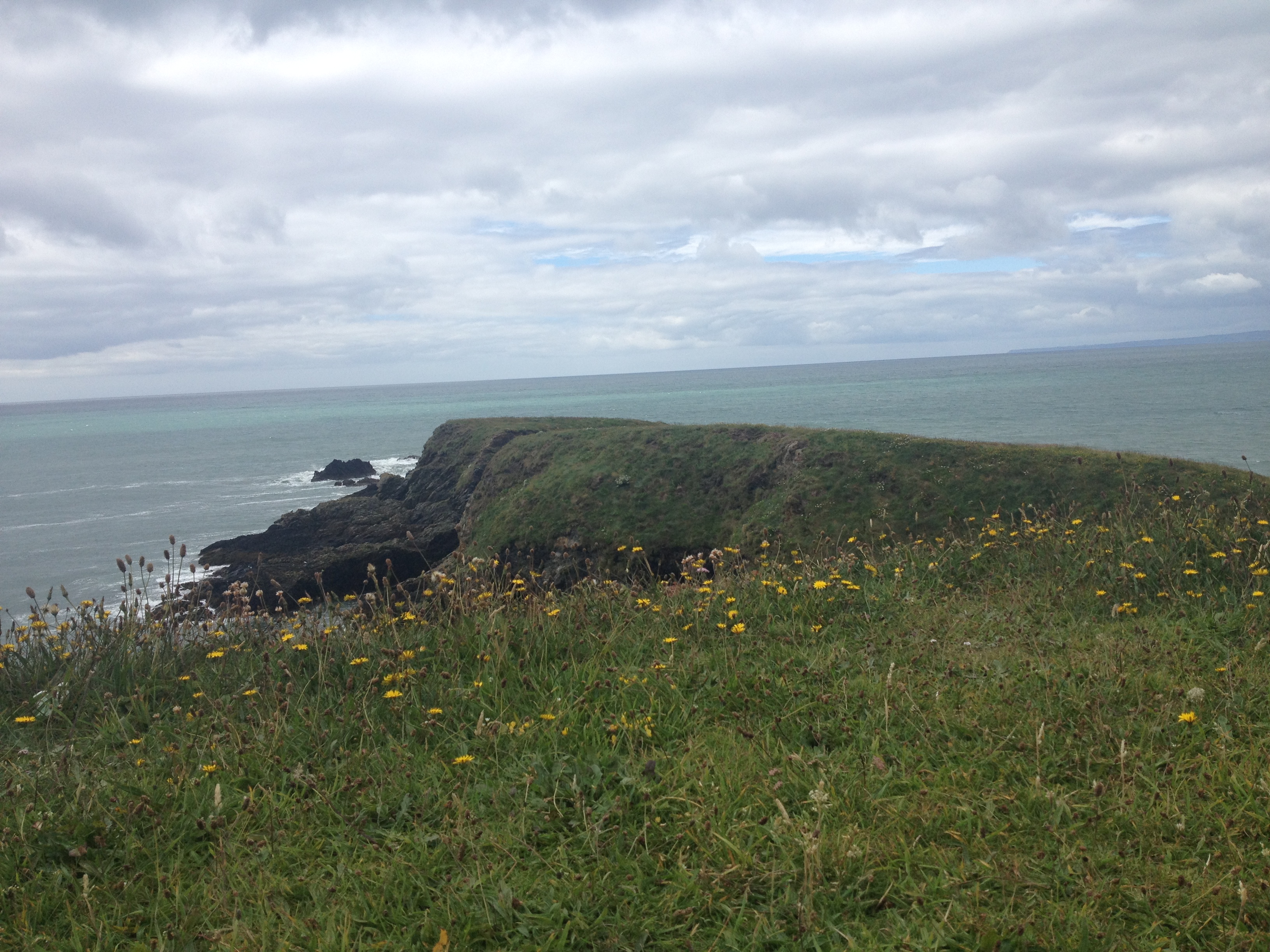
Each rhythm manifested subtly. Though I went dutifully through the entire wave, I only practiced for a half hour or so. Last summer when I was practicing independently like this—also without a teacher and without music and with the sea—my first few dances seemed lackluster, too; and I assumed that if I continued to set the intention, the practice would open up in its own time. I spread out a towel and sat in meditation following this short 5Rhythms wave, then made my way very, very carefully back down the cliff path.
I hoped that dancing would raise a sweat, but it never reached that level of exertion. I have not been getting enough exercise since I have been in Ireland; and I have craved the endorphins. Although I can usually count on practice for a workout (Gabrielle Roth—the visionary polymath who created the 5Rhythms practice even occasionally touted this benefit), I don’t like to put that much pressure on it, so I went for a vigorous run later in the afternoon, again (as mentioned in my last text) visiting the local castle ruin.
I picked Simon up from camp at 3.30. He complained mildly about his day, saying that pretty much everyone there had lots of brothers and sisters, and that he wished he had brothers and sisters, too. We stopped at a much-talked-about local playground on the way home. It had a giant, net-like rope structure to climb, a zip line, swings, slides, see-saws, and many iterations of things to climb.
Simon was playing happily with two other kids on a large spinning disk merry-go-round when he had an accident. He had been rolling off the spinning edge and tumbling away quite skillfully. I told him to roll off the other side, rather than into me and the woman who was standing next to me with a four-month-old baby strapped to her chest. The first few tumbles went fine, but the third was calamitous. Simon rolled down a hill and right into a stone wall, hitting the back of his head on a big rock with a loud “whack” sound. He started to cry right away and stood up. I ran to him and realized that the back of his head was spurting blood. I was terrified. Thankfully, the woman with the four-month-old baby sprang into action. “I need to take him to the emergency room, right?” I said breathlessly. “I think so,” she said back quickly. She tried to calm Simon down in the most cheerful, reassuring voice, while also trying to get a look at the cut. Thank Gods, Simon had no signs of concussion, but I was extremely worried. The woman helped us get to our car, bantering kindly all the while and offering to help in any way she could. I was tight with fear and kicking myself for not realizing this possible danger, and I spent the drive tight with anxiety, unable to fully address Simon’s questions about stitches and the emergency room.
Somehow I managed to get us home. Once the house was in sight, I felt like I was going to fall off the earth. I was so afraid Simon’s wound might be very bad—perhaps a puncture or a cracked skull. I imagined the worst. The bleeding had mostly stopped, but there had been so much blood for a minute or so. I was fiercely hot and ripped off my sweater. I sank to the kitchen floor, saying, “Simon, come snuggle with Mommy on the floor for a second.” The world spun and I was very close to fainting, but I told myself I had to get it together. I got Simon settled in front of some cartoons, then ran to get a bowl of water and a facecloth to wash the wound and have a look at it. I grabbed socks and a sweater, also, as I had begun to shiver and my teeth were chattering. The wound didn’t look too bad, but I couldn’t tell for sure. He still had no symptoms of concussion, but after several hours home, I decided to take him to the local hospital. Sitting in the emergency room waiting area, Simon put his little head in my lap and went to sleep. I was so worried I couldn’t even be bored. Thankfully, we were seen quickly and the doctor was confident that Simon had only a superficial wound. We set out for home shortly after midnight.
The next day, he stayed home from camp and we explored a local town all day, including the toy shop.
As we woke up the next day to prepare for camp, Simon shared that he was very nervous about something. “Mommy, what if you die while we are in Ireland and I am all alone?” I did my best to reassure him, again, but part of me was very fearful, too. Things had been going extraordinarily not-well. My mantra for the day became, “Stay alive. Stay alive. Stay alive.”
After dropping Simon off at camp, I searched at length for a car mechanic my friend had recommended. I have a big squish in the side of the rental car, and face a 1500 dollar deductible if I can’t get it repaired before I return it. (I parked next to a stone wall, where one big stone protruding outward was hidden by some greenery. The rest is history, as they say.) I finally resorted to calling the number she had given me. “Hello?” “Yes, hello, is this Maurice from Lenihan’s Garage?” “Yeah.” “My friend highly recommended you to me. I have a bad car problem and I’m trying to find you.” He asked where I was and I tried in vain to explain. He said he was next to a school. I hoped the school might come up on the GPS and asked, “What school?” “It doesn’t have a name,” he said, “We don’t really want to be found here.” That made me feel sort of unwelcome, but I did manage to find it eventually. When I arrived, Maurice scarcely looked at me, turning me over immediately to an associate who told me the job would probably cost at least 1000 euro. On the way home from there, I nearly took a casual right turn into a speeding truck, accustomed, as I am, to easy right turns, and forgetting for a moment that I am driving on the opposite side of the road. I inhaled sharply and returned to my mantra, “Stay alive. Stay alive. Stay alive.”
After, I went to a beautiful local beach. Parking, I felt constrained. Fear was wearing me out. I had not slept well, again. I was trying to talk myself out of this fear of dying that had persisted now for several days—perhaps a result of so many mishaps and mis-steps in recent days and weeks. I had to keep dragging myself back from a trance of anxiety again and again.
I intended to investigate the west end of the beach near a small surf station, then go to the beach’s east end to find a quiet place to practice, but a spot near the surf station called me. It was at sea level, not high on a sheer cliff, and not the most dramatic site in the area. The tide was very low and there was almost no surf. The west end of the beach was hemmed by a tall cliff and another tall cliff rose on the north side. The spot I chose was a little circle—perhaps eight feet across—protected by some fallen boulders.
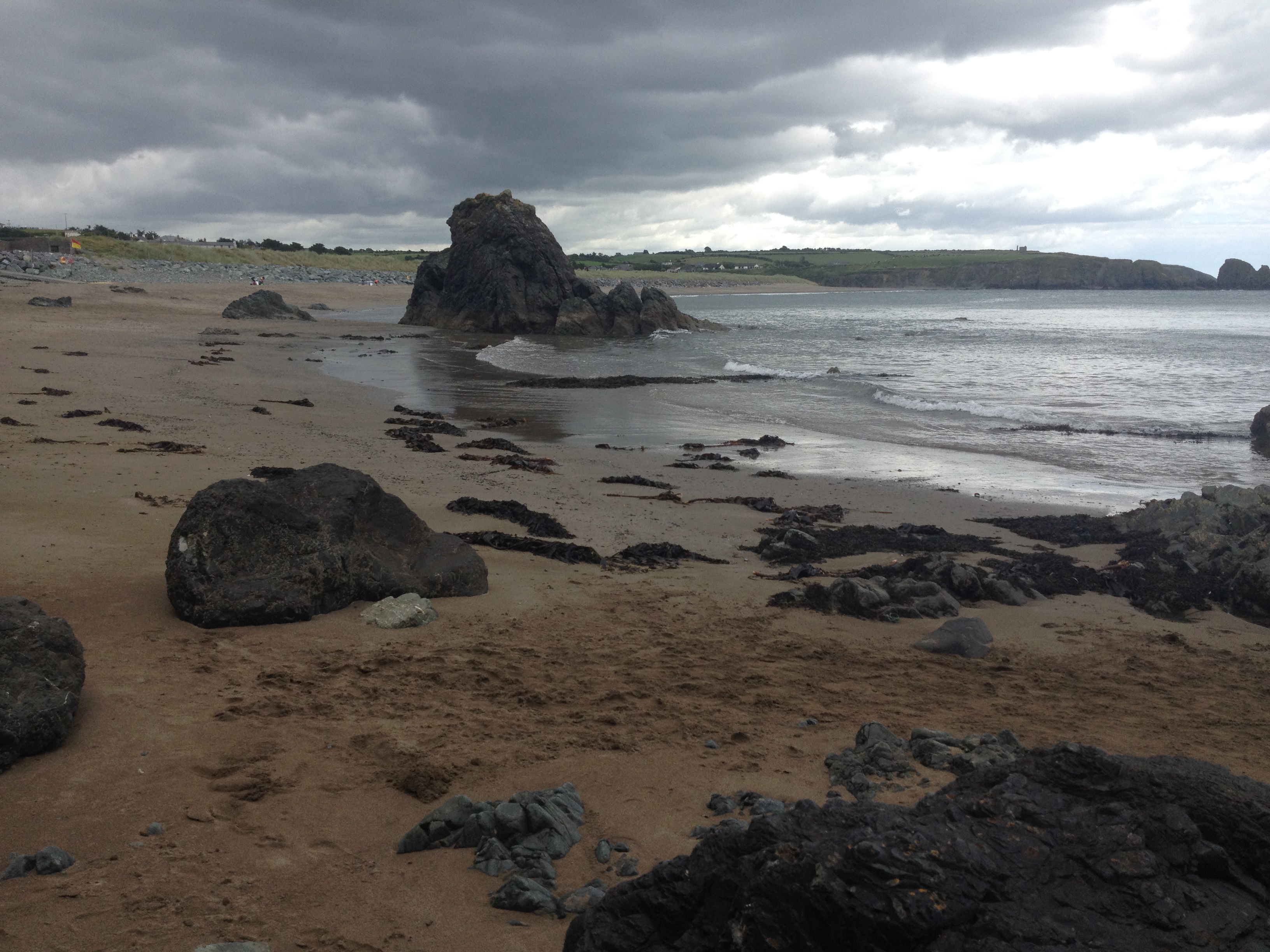
I danced a very classic 5Rhythms wave. It was classic in the sense that each of the five rhythms was fully attended to; and each rhythm had nearly equal time and weight. I began to move right away, finding Flowing easily. I was grateful to be at sea level, feeling my feet in the sand and not worrying about cliff edges. “I could stay here for hours,” I said internally, taking off my jacket as I began to warm up. The first thing that came was tears. I wanted to be taken care of—and I craved the people in my life who have been kind enough to take care of me. I cried for the expensive car issue, for the many hours I had spent lost and driving down skinny country lanes that all looked alike, and for the many moments of disempowerment, fear and frustration I have experienced. I also re-lived Simon’s accident in the playground, finding a gasp of horror (along with guilt and primal fear) that temporarily stopped the flowing, circular movements my body was finding as my feet revolved on the packed, wet sand. I found another gasp, the same one that escapes me every time I come around a harrowing blind curve in one of the skinny lanes hemmed by stone walls and thick hedges and encounter a vehicle barreling toward me from the opposite direction.
In Flowing, I let in primal fear and anxiety. Though I couldn’t fully embrace it, the idea that I could fundamentally trust the universe presented. I had been tightening, hoping if I try very hard to pay attention, I could keep us safe. Rather, I remembered that the best way to stay safe is relaxed awareness—attending to the senses and responding appropriately as things arise. The glaze of anxiety that comes from tightening against experience does the exact opposite, and leads to more errors in judgment. My heart became external and I danced with it, caring for it like a child that needs extra love and patience in the throes of a sickness. I thought about the many people I have encountered who bear so much fear and anxiety that they don’t have the energy to be pleasant or artful or inspired; and in that moment felt similarly bedraggled.
Unlike two days ago when I thought I should keep myself in Flowing, I let the rhythms change as they wanted to, this time not insisting that I stay in Flowing when my body wanted to move into Staccato. Part of deepening practice is, I think, knowing when “instinct” is really conditioned response, a way to escape something unpleasant. At these times, skillful resistance is called for. At other times, what feels like “instinct” is intuition, and, as such should be acknowledged and attended to. I realized, as Staccato arrived, that I had not served myself in slowing my entrance to Staccato the previous day. I needed to be very clear about my boundaries on the cliff. Later the same day, I also needed to step directly into Staccato when Simon had the accident in the park.
Staccato arrived. Firm. Clean. Sharp breaths powered my movements. I let myself be seen—heart and all, as I moved in and around my little rock circle—an energetically safe spot that allowed me to relax into the moment. Even vigorous Staccato did not raise a sweat as the day was still chilly, but blue sky peeked through the low clouds and warmed me; and I was able to take off my sweater.
There was so much happening inside me during this wave that I only danced for a fraction of each rhythm with the sea. Chaos was shy—not huge, but honest, real. Lyrical came and I wanted to fly, to soar with the birds overhead. As there was little wind, the birds were not soaring in great arcing gestures, but were instead fluttering and flitting, and I followed them in this, too. I did not gloss over Stillness, as I have tended to do when practicing independently in the past, but found wind, clouds and long, slow gestures.
I considered moving to a different part of the beach to do another wave, thinking I would take a moment to practice Reiki then move on, but another wave started up spontaneously. In Reiki there is a strong emphasis on healing energy in the hands; and in this case, I was once again holding my heart in my hands, and dancing with it. My movements found weight as the heart was large and heavy. I danced in and through it, at once, with weighted inertia. Staccato broke through, again, without the energy of confrontation, but clear, with a simple willingness to be seen. Succumbing to a familiar habit, right before Lyrical arrived, I had to check the phone to make sure Simon’s camp hadn’t called with any emergencies. In Lyrical in this second wave, I found a little more grace, a little more flight. I sailed up, too, in a set resembling traditional Irish step dancing, enjoying jauntiness and verticality.
Finally, I found my way back to Stillness, and back to my original Reiki intention. I saw Gabrielle, above and to my right, and drew her into my heart. Then, I experimented with expanding and contracting my energy field and with how far I could be to feel the energy of the large rocks in my circle. First, swelling to fill the whole rock circle, then contracting again to a tiny field close to my body (a layer I’ve been exploring with a friend back in New York). Using Reiki, I looked at the pain body and cleared spots of blocked energy in the diaphragm, hips, lower belly, and right back heart. At the end of the wave I practiced sitting meditation for a little while before gathering my things and leaving the beach.
When I picked him up, Simon told me he had fun at camp. The evening was relatively warm; and we went to the beach together, playing tag and several other games of Simon’s invention.
July 14, 2016, Annestown, Co. Waterford, Ireland
This blog consists of my own subjective experiences on the 5Rhythms® dancing path, and is not sanctioned by any 5Rhythms® organization or teacher.
by meghanleborious | Jul 9, 2016 | Notes on Practice
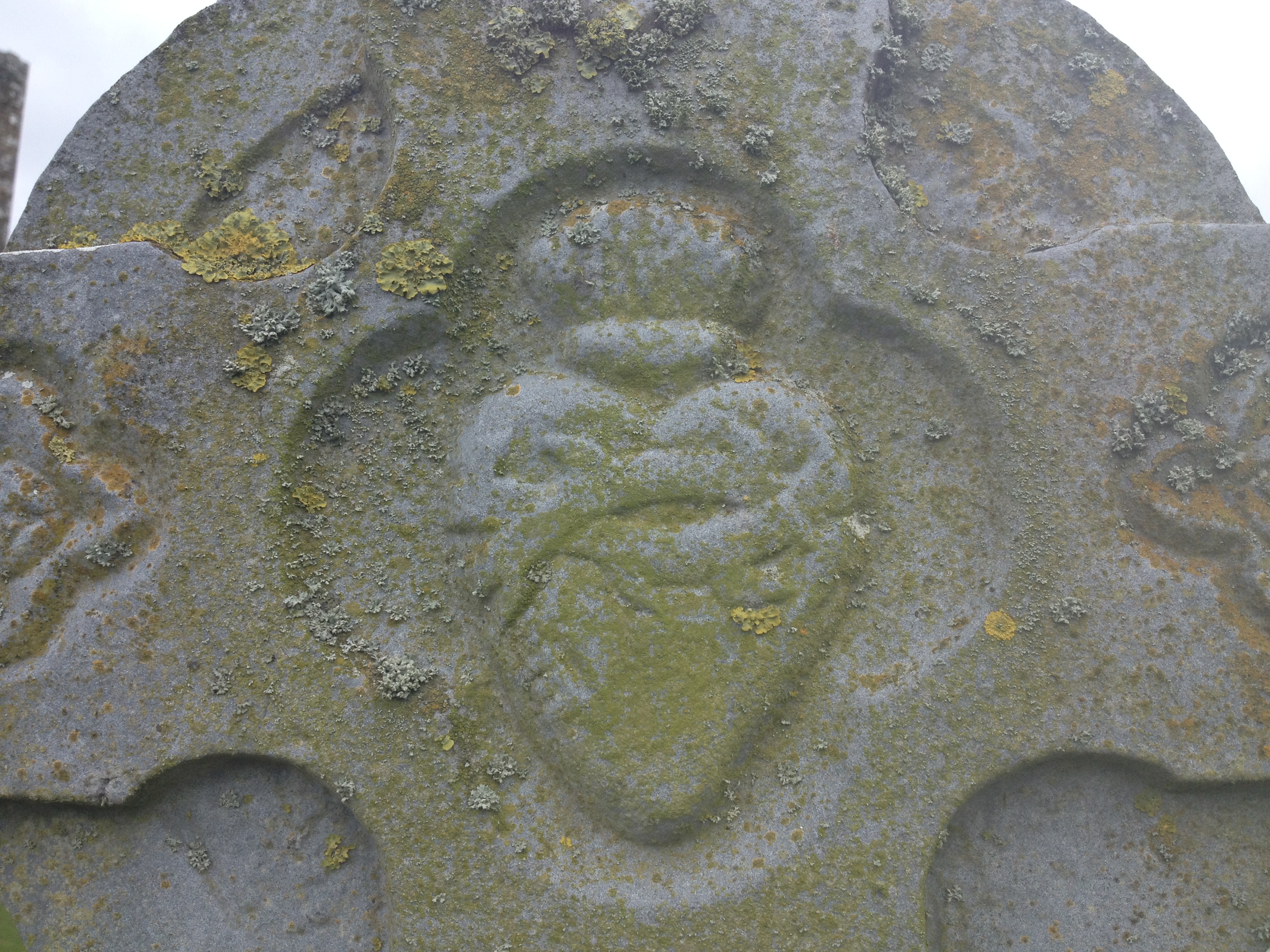
While everyone in New York is suffering through a heat wave, I have been wearing sweaters and still shivering. This is my seventh day in chilly Ireland, traveling with my six-year-old son, Simon. First, we explored the astonishingly beautiful western region of Connemara. In Connemara, there is water everywhere. Lush vegetation goes all the way to the edges of every puddle, lake and river, giving the impression that everything is extremely full. Rock juts up through the green in impressive, unpeopled, ancient mountains. Rolling fields patchworked in different greens and hemmed by squared stone walls stretch all the way to the ocean’s edge. Textured layerings of green plants cover everything, even overtaking rock walls and sea cliffs—though in an entirely cheerful proliferation, nothing of sinister engulfment or of overwhelming insistence.
On our first full day in Annestown, on the Southeast coast of Ireland where we are staying at the house of a good friend, Simon got completely soaked. I didn’t even bring a change of clothes to the beach because it didn’t cross my mind that he might frolic in the waves on such a foggy, cold day; but he met a new friend and they raced happily in and out of the water. (It should be so easy for all of us! “You are about my size. You are willing to run with me. You are my friend!”) Truthfully, it seems almost that easy here with adults, too.
The next day, Simon and I trekked from late morning until evening in search of a local castle. With some trial and error, we managed to locate a nearby path our friend had mentioned that leads to the ruined palace. As we neared the castle, the path grew narrow and steep, with vegetation enclosing us as we ascended. Having been stung by nettles the day before, Simon moved forward hesitantly. Emerging, we were the only castle visitors. There was a discreet board with information in Irish, but no other signs of tourism. The castle rose above us, overgrown and chipped away, but nonetheless impressive. I put the picnic bag down on a flat, grassy spot, thinking we would explore the interior, then picnic there. Ascending further, I realized there was yet another, higher, even more beautiful grassy spot to picnic that looked for miles over green farmland. We explored the one room that was left of the castle’s interior, looking out through the window opening on each of four sides, then sat down to a picnic of Irish brown bread, sliced turkey and plums.
After our picnic lunch, we spotted a way to climb up a ledge of stones to the castle’s second floor. Perhaps against my better judgement, Simon and I climbed up and took in the views from this even higher perch. I held my breath and kept him away from the edges, still noting that even the roof sported lush turf and abundant greenery. Descending was more challenging; and there was a moment that I gasped with fear, but Simon followed my directions carefully and we made it without injury back to the level of our picnic.
We continued to walk along the path all the way into the next village, and slowly became cognizant of the tiny faery doors that dotted the woods. One was a four-inch tall wooden door carved with celtic scrollwork. Another featured tiny stairs. And yet another—moldings and trim. Most were at a convenient level for faeries and attached to a lower tree trunk. We made offerings of flowers at each door and asked the faeries to help with many special intentions. To my swelling pride, Simon included prayers for the happiness and well-being of the faeries, in addition to many prayers for him, for me, and for friends and family members.
Simon slowed down considerably as he grew tired. At one point, he stopped moving forward and closed his eyes. He began to move his hands slowly, perhaps imitating people he has seen doing tai chi in the parks of New York City. He wanted me to follow him, but soon realized that for this kind of dancing, it was more fun to do it on your own. I, too, moved slowly, my arms gently guiding my my gestures, my breath audible. Wind rustling through the marsh grasses passed through my body. For the first time, I noted that the direction of my gesture might not be the same direction as the energy that moved around me, but the different fields could be in harmony, like the different forces at play in a tide. My shoulders and upper back wanted to unfold and unfurl. (Stillness reveals itself to me in stages.)
Eventually, Simon started moving forward again, and we went to try to find a shop in the village near the end of the path where we heard we could get some ice cream.
Although there are 5Rhythms teachers and practitioners in Ireland, there are no scheduled events during the time of my stay. I am planning to undertake formal, individual practice as soon as Simon starts camp on Monday, though I am not tricked by the pretense that the practice happens only when I declare that it is happening. Instead, I hope I will be open to all the magic that presents—especially when it is as obvious as faery doors.
July 8, 2016, Annestown, Co. Waterford, Ireland
(Note: After this writing I learned about two new instances of police killings of black men in the US, and of the rising tide of rage and mixed feelings in response. I hope this lyrical foray does not offend anyone who is deep in the throes of agony, praying for a new dawn of tolerance and of enlightened policy.)
This blog consists of my own subjective experiences on the 5Rhythms® dancing path, and is not sanctioned by any 5Rhythms® organization or teacher.










